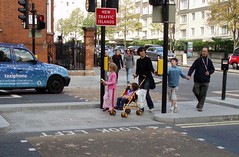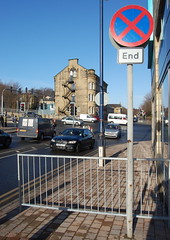nick wright planning
NEWS
designing streets
By Nick Wright
on February 01, 2009
all posts
culture change
 It's only a weeks since the Scottish Government announced its investment proposals for how to improve the connections between our towns and cities (the Strategic Transport Projects Review, see my blog article here). Now they've issued draft policy and guidance at the other end of the transport planning spectrum - how we should design streets within our towns and cities.
Designing Streets focusses on streets not simply as routes for vehicles, but as an integral part of successful, sustainable, well-designed communities. Like its recent counterpart in England and Wales, Manual for Streets, it puts good design and place-making at the heart of street design.
As the draft policy says, for too long the principal focus has been on the movement function of streets. The result has often been places that are dominated by motor vehicles and so fail to make a positive contribution to achieving a good quality of life.
Designing Streets assigns a higher priority to pedestrians and cyclists. It recognises their role in creating places that benefit all members of the community. The document refocuses on place-making, giving guidance on how to achieve well-designed streets and spaces that serve the community in a range of ways.
It's only a weeks since the Scottish Government announced its investment proposals for how to improve the connections between our towns and cities (the Strategic Transport Projects Review, see my blog article here). Now they've issued draft policy and guidance at the other end of the transport planning spectrum - how we should design streets within our towns and cities.
Designing Streets focusses on streets not simply as routes for vehicles, but as an integral part of successful, sustainable, well-designed communities. Like its recent counterpart in England and Wales, Manual for Streets, it puts good design and place-making at the heart of street design.
As the draft policy says, for too long the principal focus has been on the movement function of streets. The result has often been places that are dominated by motor vehicles and so fail to make a positive contribution to achieving a good quality of life.
Designing Streets assigns a higher priority to pedestrians and cyclists. It recognises their role in creating places that benefit all members of the community. The document refocuses on place-making, giving guidance on how to achieve well-designed streets and spaces that serve the community in a range of ways.
collaboration
Lead author, Keith Gowenlock of consultants WSP's Edinburgh office, says that one of the key messages is collaboration. Designing Streets may appear on the surface to be about making streets that work better for everyone; but achieving that requires a massive shift in the way that streets are designed. Preparation of the document, and the accompanying awareness-raising efforts, have not shied away from this challenge. Conventionally, consultants design road layouts and local authorities then audit them against strict technical guidelines. Designing Streets involves a more collaborative approach. Designers and regulators should work together designing not by ticking boxes against technical rules, but by applying a series of principles - layout and connectivity, quality places, street users' needs and so on. The all-powerful role of the Safety Audit has also been thoroughly reviewed. No longer will a finalised scheme be subject to the veoto of the Safety Audit, where any risk must be designed out before the new design can be implemented - the result being a proliferation of guard rails, signs and other safety features, most of which serve to create a placeless, hostile environment. The process inevitably urges all other factors - quality of life, encouraging walking and cycling, health benefits - to be sacrificed on the altar of eliminating risk.
Now, Safety and Quality Audits are being introduced. The inclusion of the word 'quality' in the description says it all. No longer is risk the sole arbitor of design: contribution to the built environment and other agendas will be taken into account too. Risk should be managed rather than eliminated, and assessed against other criteria.
Equally importantly, the Audit will be integrated into the whole design process rather than take place as a veto at the end. More evidence of that principle of collaboration.
The all-powerful role of the Safety Audit has also been thoroughly reviewed. No longer will a finalised scheme be subject to the veoto of the Safety Audit, where any risk must be designed out before the new design can be implemented - the result being a proliferation of guard rails, signs and other safety features, most of which serve to create a placeless, hostile environment. The process inevitably urges all other factors - quality of life, encouraging walking and cycling, health benefits - to be sacrificed on the altar of eliminating risk.
Now, Safety and Quality Audits are being introduced. The inclusion of the word 'quality' in the description says it all. No longer is risk the sole arbitor of design: contribution to the built environment and other agendas will be taken into account too. Risk should be managed rather than eliminated, and assessed against other criteria.
Equally importantly, the Audit will be integrated into the whole design process rather than take place as a veto at the end. More evidence of that principle of collaboration.